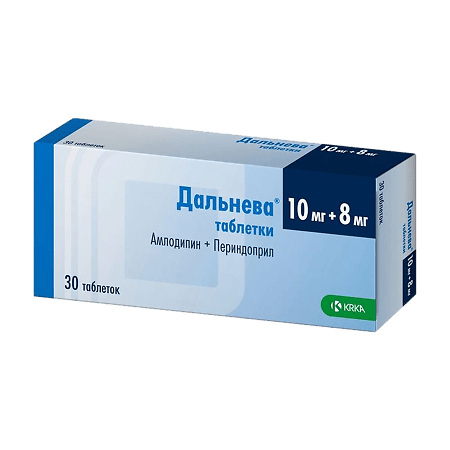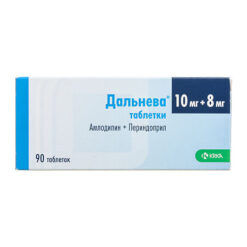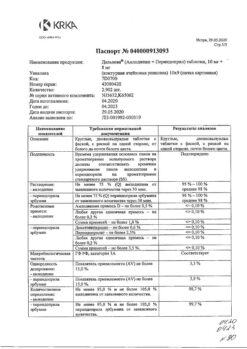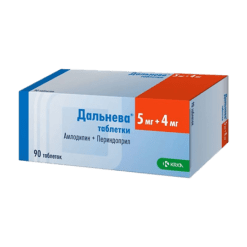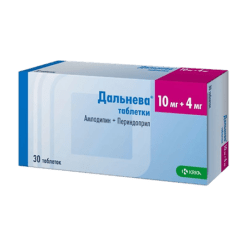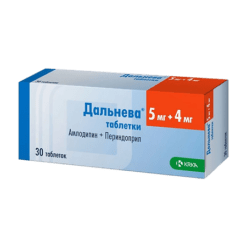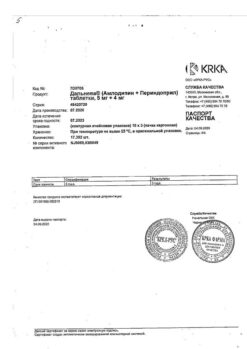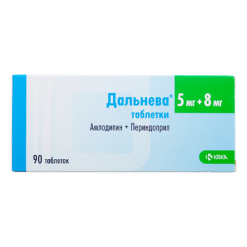No products in the cart.
Dalneva, 10 mg+8 mg tablets 30 pcs
€20.08 €16.73
Description
hypotensive combination therapy (angiotensin-converting enzyme inhibitor [ACE] + slow calcium channel blocker [CCB])
Indications
Indications
Arterial hypertension and/or coronary heart disease: stable angina pectoris in patients who require therapy with perindopril and amlodipine.
Pharmacological effect
Pharmacological effect
antihypertensive combination drug (angiotensin-converting enzyme inhibitor [ACE] + slow calcium channel blocker [SCBC])
Special instructions
Special instructions
Renal artery stenosis (including bilateral), single functioning kidney, liver failure, renal failure, systemic connective tissue diseases (including systemic lupus erythematosus, scleroderma), therapy with immunosuppressants, allopurinol, procainamide (risk of developing neutropenia, agranulocytosis), reduced circulating blood volume (CBV) (taking diuretics, salt-free diet, vomiting, diarrhea), atherosclerosis, cerebrovascular diseases, ischemic heart disease with severe obstructive lesions of the coronary arteries, acute myocardial infarction (and the period within 1 month after it), unstable angina, sick sinus syndrome (severe tachycardia, bradycardia), renovascular hypertension, diabetes mellitus, primary hyperaldosteronism, CHF, simultaneous use of inhibitors or inducers of the CYP3A4 isoenzyme, dantrolene, estramustine, potassium-sparing diuretics, potassium supplements, potassium-containing table salt substitutes, lithium preparations, clarithromycin, tacrolimus, cyclosporine, hyperkalemia, surgery/general anesthesia, elderly patients, depression bone marrow hematopoiesis, history of aggravated allergies or angioedema, hemodialysis using high-flow membranes (for example, AN69®), desensitization therapy, low-density lipoprotein (LDL) apheresis, aortic stenosis/mitral stenosis/hypertrophic obstructive cardiomyopathy (HOCM), use in black patients, CHF non-ischemic etiology III-IV functional class according to the NYHA classification.
The drug Dalneva® should not be prescribed to children and adolescents under 18 years of age, since there is no data on the effectiveness and safety of the use of perindopril and amlodipine in these groups of patients, either in monotherapy or as part of combination therapy.
Patients with impaired renal function
The drug Dalneva® can be used in patients with CC equal to or more than 60 ml/min.
The drug Dalneva® is contraindicated for use in patients with CC less than 60 ml/min. In such patients, individual selection of doses of perindopril and amlodipine is recommended. Changes in the concentration of amlodipine in blood plasma do not correlate with the severity of renal failure.
Elderly patients and patients with impaired liver function
It is necessary to reduce the initial dose of Dalneva® to the one containing the lowest dose of amlodipine (i.e., to 1 tablet of amlodipine 5 mg + perindopril 4 mg or amlodipine 5 mg + perindopril 8 mg).
Special instructions regarding perindopril and amlodipine also apply to the drug Dalneva®.
Amlodipine
The effectiveness and safety of amlodipine in hypertensive crisis has not been established.
Heart failure
Patients with heart failure should be treated with caution.
When using amlodipine in patients with CHF functional class III and IV according to the NYHA classification, pulmonary edema may develop. BMCCs, including amlodipine, should be used with caution in patients with CHF due to a possible increased risk of adverse events from the cardiovascular system and mortality.
Liver failure
In patients with impaired liver function, T½ and AUC of amlodipine increase. Recommendations for dosing of the drug have not been established. Amlodipine should be started with the lowest doses and precautions should be taken both at the beginning of treatment and when increasing the dose. In patients with severe hepatic impairment, the dose should be increased gradually, ensuring careful monitoring of the clinical condition.
Elderly patients
In elderly patients, increasing the dose should be done with caution (see sections “Dosage and Administration” and “Pharmacological properties. Pharmacokinetics”).
Kidney failure
Patients with renal failure can take amlodipine in standard doses. Changes in plasma concentrations of amlodipine do not correlate with the degree of renal failure. Amlodipine is not excreted from the body by dialysis.
Mitral stenosis/aortic stenosis/HOCM
Amlodipine is contraindicated in patients with left ventricular outflow tract obstruction.
Withdrawal syndrome
Despite the absence of withdrawal syndrome in BMCC, it is advisable to discontinue treatment with Dalneva® gradually, reducing the dose of the drug. Amlodipine does not prevent the development of withdrawal syndrome after abrupt cessation of beta-blockers.
Peripheral edema
Mild to moderate peripheral edema was the most common adverse event of amlodipine in clinical studies. The incidence of peripheral edema increases with increasing dose (when using amlodipine at a dose of 2.5 mg, 5 mg and 10 mg per day, edema occurred in 1.8%, 3% and 10% of patients, respectively). Peripheral edema associated with the use of amlodipine should be carefully differentiated from symptoms of progression of left ventricular heart failure.
Other
It is necessary to maintain dental hygiene and follow-up with a dentist (to prevent pain, bleeding and gum hyperplasia).
Perindopril
Hypersensitivity/angioedema (Quincke’s edema)
When using ACE inhibitors, including perindopril, in rare cases, the development of angioedema of the face, lips, tongue, vocal folds and/or larynx may occur. This can happen at any time. If these symptoms appear, the use of Dalneva® should be stopped immediately, and the patient should be observed until signs of edema disappear completely. If angioedema affects only the face and lips, its manifestations usually go away on their own, or antihistamines can be used to treat its symptoms. Angioedema, accompanied by swelling of the tongue or larynx, can lead to airway obstruction and death. If such symptoms appear, epinephrine (adrenaline) at a dilution of 1:1000 (0.3 or 0.5 ml) should be immediately administered subcutaneously and/or ensure airway patency. The patient should be under medical supervision until symptoms disappear completely and permanently.
Patients with a history of angioedema not associated with the use of ACE inhibitors may have an increased risk of developing it when using drugs of this group (see section “Contraindications”).
In rare cases, intestinal angioedema (angioedema of the intestine) develops during therapy with ACE inhibitors. In this case, patients experience abdominal pain as an isolated symptom or in combination with nausea and vomiting, in some cases without previous angioedema of the face and with normal serum concentrations of C1-esterase. The diagnosis is made using computed tomography of the abdominal cavity, ultrasound, or at the time of surgery. Symptoms disappear after stopping the use of ACE inhibitors. Therefore, in patients with abdominal pain receiving ACE inhibitors, when making a differential diagnosis, it is necessary to take into account the possibility of developing intestinal angioedema (see section “Side effects”).
When ACE inhibitors are used concomitantly with racecadotril, mTOR inhibitors (for example, temsirolimus, everolimus, sirolimus) or DPP-IV (gliptins, including vildagliptin), the risk of developing angioedema (for example, swelling of the upper respiratory tract or tongue, with or without impairment of respiratory function) increases (see section “Interaction with other drugs”).
Caution should be exercised when initiating therapy with racecadotril, mTOR inhibitors (eg, temsirolimus, everolimus, sirolimus) or gliptins, including vildagliptin, when used concomitantly with ACE inhibitors.
Anaphylactoid reactions during desensitization procedures
There are isolated reports of the development of prolonged, life-threatening anaphylactoid reactions in patients receiving ACE inhibitors during desensitization therapy with hymenoptera venom. In these same patients, an anaphylactoid reaction was avoided by temporarily discontinuing ACE inhibitors, and if the drug was accidentally taken, the anaphylactoid reaction occurred again.
Anaphylactoid reactions during LDL apheresis using dextran sulfate
In rare cases, life-threatening anaphylactoid reactions may occur in patients receiving ACE inhibitors during LDL apheresis using dextran sulfate. To prevent an anaphylactoid reaction, ACE inhibitor therapy should be temporarily discontinued before each LDL apheresis procedure using dextran sulfate.
Neutropenia/agranulocytosis, thrombocytopenia and anemia
In patients taking ACE inhibitors, cases of neutropenia/agranulocytosis, thrombocytopenia and anemia may develop. In patients with normal renal function in the absence of other aggravating factors, neutropenia rarely develops.
Perindopril should be used with extreme caution in patients with systemic connective tissue diseases, while taking immunosuppressants, allopurinol or procainamide, especially in patients with impaired renal function.
Some patients developed severe infections, in some cases resistant to intensive antibiotic therapy. When prescribing perindopril to such patients, it is recommended to periodically monitor the number of leukocytes in the blood. Patients should report any signs of infectious diseases (eg, sore throat, fever) to their doctor.
Renovascular hypertension
In patients with bilateral renal artery stenosis or arterial stenosis of a single functioning kidney, the risk of developing arterial hypotension and renal failure increases during therapy with ACE inhibitors. Taking diuretics may be an additional risk factor. Deterioration of renal function can be observed with even a slight change in serum creatinine concentration, even in patients with unilateral renal artery stenosis.
Double blockade of the RAAS
There is evidence that the simultaneous use of ACE inhibitors, ARB II or aliskiren increases the risk of arterial hypotension, hyperkalemia and renal dysfunction (including acute renal failure). The simultaneous use of ACE inhibitors with drugs containing aliskiren is contraindicated in patients with diabetes mellitus and/or moderate or severe renal impairment (GFR less than 60 ml/min/1.73 m2 body surface area) and is not recommended in other patients. If therapy with dual blockade of the RAAS is considered absolutely necessary, it should only be carried out under strict medical supervision and with regular monitoring of renal function, plasma electrolytes and blood pressure. The use of ACE inhibitors simultaneously with ARA II is contraindicated in patients with diabetic nephropathy and is not recommended in other patients (see section “Contraindications”).
Primary hyperaldosteronism
Patients with primary hyperaldosteronism are usually not susceptible to antihypertensive drugs whose action is based on inhibition of the RAAS. Therefore, taking the drug is not recommended.
Arterial hypotension
ACE inhibitors can cause a sharp decrease in blood pressure. Symptomatic hypotension rarely develops in patients without concomitant diseases. The risk of a pronounced decrease in blood pressure is increased in patients with reduced blood volume, which can be observed during diuretic therapy, following a strict salt-free diet, hemodialysis, diarrhea and vomiting, as well as in patients with severe hypertension with high renin activity (see sections “Interaction with other drugs” and “Side effects”). In patients at increased risk of developing symptomatic arterial hypotension, blood pressure, renal function and serum potassium levels should be carefully monitored during treatment with Dalneva®.
A similar approach is also used in patients with angina pectoris and cerebrovascular diseases, in whom severe arterial hypotension can lead to myocardial infarction or cerebrovascular accident.
If arterial hypotension develops, the patient should be transferred to the supine position with legs elevated. If necessary, the blood volume should be replenished using intravenous administration of 0.9% sodium chloride solution. Transient arterial hypotension is not an obstacle to further taking the drug. After restoration of blood volume and blood pressure, treatment can be continued.
Mitral stenosis/aortic stenosis/HOCM
Perindopril, like other ACE inhibitors, should be prescribed with caution in patients with left ventricular outflow tract obstruction (aortic stenosis, HOCM), as well as in patients with mitral stenosis. Amlodipine is contraindicated in patients with left ventricular outflow tract obstruction.
Renal dysfunction
For patients with renal failure (creatinine clearance less than 60 ml/min), individual selection of doses of perindopril and amlodipine is recommended (see section “Dosage and Administration”). Such patients require regular monitoring of potassium levels and creatinine concentrations in the blood serum (see section “Side Effects”).
In patients with bilateral renal artery stenosis or stenosis of the artery of a single kidney during therapy with ACE inhibitors, an increase in serum urea and creatinine concentrations is possible, which usually resolves when therapy is discontinued. This effect is most often observed in patients with renal failure. The additional presence of renovascular hypertension causes an increased risk of severe hypotension and renal failure in such patients. In some patients with hypertension without signs of renal vascular damage, an increase in serum urea and creatinine concentrations is possible, especially when perindopril is co-administered with a diuretic, usually slight and transient. This effect is more often observed in patients with pre-existing renal impairment.
Liver dysfunction
On rare occasions
Active ingredient
Active ingredient
Amlodipine, Perindopril
Composition
Composition
per 1 tablet 5 mg + 4 mg/10 mg + 4 mg/5 mg + 8 mg/10 mg + 8 mg
Active ingredients:
Amlodipine besilate (amlodipine besilate) 6.935 mg/13.870 mg/6.935 mg/13.870 mg, equivalent to amlodipine 5 mg/10 mg/5 mg/10 mg
Perindopril erbumine A substance – granules 21,000 mg/21,000 mg/42,000 mg/42,000 mg, contains perindopril erbumine 4 mg/4 mg/8 mg/8 mg
Excipients:
Microcrystalline cellulose, pregelatinized starch, sodium carboxymethyl starch, sodium bicarbonate, colloidal silicon dioxide, magnesium stearate
Pregnancy
Pregnancy
Dalneva® is contraindicated during pregnancy.
Dalneva® is not recommended for use during breastfeeding. It is necessary to assess the significance of therapy for the mother in order to decide whether to stop breastfeeding or discontinue the drug.
Pregnancy
Amlodipine
The safety of amlodipine during pregnancy has not been established.
In experimental studies on animals, the fetotoxic and embryotoxic effects of the drug were established when used in high doses. Use during pregnancy is only possible if there is no safer alternative and when the disease carries a greater risk for the mother and fetus.
Perindopril
The use of ACE inhibitors is not recommended for use in the first trimester of pregnancy (see section “Special instructions”). The use of ACE inhibitors is contraindicated in the second and third trimesters of pregnancy (see sections “Contraindications” and “Special instructions”).
At the moment, there is no irrefutable epidemiological data on the teratogenic risk when taking ACE inhibitors in the first trimester of pregnancy. However, a slight increase in the risk of fetal developmental disorders cannot be excluded. When planning pregnancy, you should discontinue Dalneva® and prescribe other antihypertensive drugs approved for use during pregnancy. If pregnancy is established, therapy with ACE inhibitors should be immediately discontinued and, if necessary, other therapy should be prescribed.
It is known that the effect of ACE inhibitors on the fetus in the second and third trimesters of pregnancy can lead to disruption of its development (decreased renal function, oligohydramnios, delayed ossification of the skull bones) and the development of complications in the newborn (renal failure, arterial hypotension, hyperkalemia).
If the patient received ACE inhibitors in the second or third trimester of pregnancy, it is recommended to conduct an ultrasound examination to assess the condition of the skull bones and renal function of the fetus/child.
Newborns whose mothers received ACE inhibitors during pregnancy should be under close medical supervision due to the risk of developing arterial hypotension (see sections “Contraindications” and “Special Instructions”).
Breastfeeding period
Amlodipine
Amlodipine is excreted in breast milk. The proportion of maternal dose received by the infant was estimated with an interquartile range of 3–7%, up to a maximum of 15%. The effect of amlodipine on newborns is unknown. The decision to continue/discontinue therapy or breastfeeding should be made taking into account the benefits of breastfeeding for the child and the benefits of taking amlodipine for the mother.
Perindopril
Due to the lack of information regarding the use of perindopril during breastfeeding, the use of perindopril is not recommended; it is preferable to use an alternative treatment with a better established safety profile during breastfeeding, especially when feeding newborns or premature infants.
Contraindications
Contraindications
Hypersensitivity to perindopril or other ACE inhibitors, amlodipine and other dihydropyridine derivatives, as well as to the excipients included in the drug.
History of angioedema (Quincke’s edema) (including while taking other ACE inhibitors).
Hereditary/idiopathic angioedema.
Concomitant use with aliskiren and medicinal products containing aliskiren in patients with diabetes mellitus and/or moderate or severe renal impairment (GFR < 60 ml/min/1.73 m2 body surface area) (see sections “Interaction with other drugs” and “Pharmacological properties. Pharmacodynamics”).
Concomitant use with ARA II in patients with diabetic nephropathy (see section "Special Instructions").
· Concomitant use with neutral endopeptidase inhibitors (for example, with drugs containing sacubitril) due to the high risk of developing angioedema.
Extracorporeal therapy leading to contact of blood with negatively charged surfaces (see section “Interaction with other drugs”).
Severe bilateral renal artery stenosis or stenosis of the artery of a single functioning kidney (see section “Special Instructions”).
Severe arterial hypotension (systolic blood pressure less than 90 mm Hg).
Shock (including cardiogenic).
Left ventricular outflow tract obstruction (eg, clinically significant aortic stenosis).
Hemodynamically unstable heart failure after acute myocardial infarction.
Renal failure (creatinine clearance [CC] less than 60 ml/min).
Pregnancy and breastfeeding period.
Age up to 18 years (efficacy and safety have not been established).
Interaction
Interaction
Amlodipine
Not recommended drug combinations
Dantrolene (intravenous administration)
In laboratory animals, cases of ventricular fibrillation with death and collapse have been reported during the use of verapamil and intravenous dantrolene, accompanied by hyperkalemia. Due to the risk of developing hyperkalemia, concomitant use of BMCCs, including amlodipine, should be avoided in patients susceptible to malignant hyperthermia, as well as during the treatment of malignant hyperthermia.
Combinations of drugs requiring special attention
Inducers of the CYP3A4 isoenzyme: when used simultaneously with inducers of the CYP3A4 isoenzyme, the concentration of amlodipine in the blood plasma may change. Therefore, it is necessary to monitor blood pressure and adjust the dose both during and after their simultaneous use, especially when used with strong inducers of the CYP3A4 isoenzyme (for example, rifampicin, St. John’s wort preparations).
Inhibitors of the CYP3A4 isoenzyme: simultaneous use of amlodipine and strong or moderate inhibitors of the CYP3A4 isoenzyme (protease inhibitors, azole antifungals, macrolides, for example, erythromycin or clarithromycin, verapamil or diltiazem) can lead to a significant increase in the concentration of amlodipine in the blood plasma. Clinical manifestations of these pharmacokinetic abnormalities may be more pronounced in elderly patients. In this regard, monitoring of the clinical condition and dose adjustment may be required.
Patients taking amlodipine concomitantly with clarithromycin are at increased risk of developing arterial hypotension. Patients receiving perindopril concomitantly with clarithromycin should be closely monitored.
Drug combinations requiring attention
Amlodipine enhances the antihypertensive effect of antihypertensive drugs.
Tacrolimus: There is a risk of increased serum concentrations of tacrolimus when administered concomitantly with amlodipine. To avoid the development of toxic effects of tacrolimus during simultaneous use of these drugs, monitoring of serum concentrations of tacrolimus and adjustment of its dose if necessary is required.
Cyclosporine: Interaction studies between cyclosporine and amlodipine have not been conducted in healthy volunteers or other populations, except in patients who have undergone renal transplantation, in which variable increases in trough cyclosporine plasma concentrations have been observed (average 0% to 40%). The possibility of monitoring the serum concentration of cyclosporine in patients after kidney transplantation when used simultaneously with amlodipine should be considered. If necessary, the dose of cyclosporine should be reduced.
Simvastatin: With the simultaneous use of multiple doses of amlodipine 10 mg and simvastatin 80 mg, an increase in simvastatin exposure by 77% was observed compared with simvastatin alone. In patients taking Dalneva® at a dosage of 10 mg + 4 mg or 10 mg + 8 mg, simvastatin should be limited to 20 mg per day.
Concomitant use of amlodipine and consumption of grapefruits or grapefruit juice is not recommended due to the possible increase in the bioavailability of amlodipine in some patients, which in turn may lead to increased blood pressure lowering effects.
mTOR inhibitors (mammalian target of rapamycin): mTOR inhibitors, such as sirolimus, temsirolimus and everolimus, are substrates of the CYP3A isoenzyme. Amlodipine is a weak inhibitor of the CYP3A isoenzyme. When used concomitantly with mTOR inhibitors, amlodipine may increase their exposure.
Clarithromycin: Clarithromycin is an inhibitor of the CYP3A4 isoenzyme. There is an increased risk of developing arterial hypotension in patients concomitantly using clarithromycin with amlodipine. Careful monitoring of patients is recommended during concomitant use of amlodipine with clarithromycin.
Simultaneous use of beta-blockers (bisoprolol, metoprolol) and the alpha- and beta-blocker carvedilol for CHF: increases the risk of developing arterial hypotension and worsening the course of CHF in patients with uncontrolled or latent CHF (increased inotropic effect). In addition, beta-blockers can reduce excessive reflex cardiac sympathetic activation associated with concomitant CHF.
With simultaneous use, amlodipine may increase the systemic exposure of tasonermin in blood plasma. In such cases, regular monitoring of the concentration of tasonermin in the blood plasma and dose adjustment if necessary is necessary.
Other drug combinations
Calcium supplements can reduce the effect of BMCC.
With the simultaneous use of BMCC with lithium preparations (no data are available for amlodipine), their neurotoxicity (nausea, vomiting, diarrhea, ataxia, tremor, tinnitus) may increase.
In clinical drug interaction studies, amlodipine had no effect on the pharmacokinetics of atorvastatin, digoxin, or warfarin.
A single dose of 100 mg of sildenafil in patients with essential hypertension does not affect the pharmacokinetic parameters of amlodipine.
Perindopril
Data from clinical studies show that dual blockade of the RAAS as a result of the simultaneous use of ACE inhibitors, ARB II or aliskiren leads to an increased incidence of adverse events such as arterial hypotension, hyperkalemia and renal dysfunction (including acute renal failure), compared with situations where only one drug acting on the RAAS is used (see sections “Pharmacological properties. Pharmacodynamics”, “Contraindications”, “Special instructions”).
Drugs that cause hyperkalemia
Certain drugs may increase the risk of hyperkalemia: aliskiren, potassium salts, potassium-sparing diuretics, ACE inhibitors, ARB II, non-steroidal anti-inflammatory drugs (NSAIDs), heparin, immunosuppressants such as cyclosporine or tacrolimus, trimethoprim, including the fixed combination of trimethoprim and sulfamethoxazole (co-trimoxazole). The combination of these drugs increases the risk of developing hyperkalemia.
Cyclosporine: with simultaneous use of ACE inhibitors with cyclosporine, hyperkalemia may develop. It is recommended to monitor serum potassium levels.
Heparin: possible increase in serum potassium levels. It is recommended to monitor serum potassium levels.
Concomitant use is contraindicated
Aliskiren and medicinal products containing aliskiren
Concomitant use of ACE inhibitors with medicinal products containing aliskiren is contraindicated in patients with diabetes mellitus and/or moderate or severe renal impairment (GFR less than 60 ml/min/1.73 m2 body surface area) and is not recommended in other patients. (see section “Contraindications”). The risk of hyperkalemia, deterioration of renal function, cardiovascular morbidity and mortality increases.
Extracorporeal therapy
Extracorporeal treatments that expose blood to negatively charged surfaces, such as dialysis or hemofiltration using certain high-flux membranes (eg, polyacrylonitrile), or LDL apheresis using dextran sulfate, are contraindicated due to the increased risk of severe anaphylactoid reactions (see section “Contraindications”). If the patient requires extracorporeal therapy, the use of a different type of dialysis membrane or a different class of antihypertensive drugs should be considered.
Neutral endopeptidase inhibitors
When ACE inhibitors are used simultaneously with drugs containing sacubitril (neprilysin inhibitor), the risk of developing angioedema increases, and therefore the simultaneous use of these drugs is contraindicated. ACE inhibitors should be prescribed no earlier than 36 hours after discontinuation of drugs containing sacubitril. Prescription of drugs containing sacubitril is contraindicated in patients receiving ACE inhibitors, as well as within 36 hours after discontinuation of ACE inhibitors.
Not recommended drug combinations
Aliskiren and medicinal products containing aliskiren
In patients without diabetes mellitus or renal impairment, there may be an increased risk of hyperkalemia, worsening renal function, and increased incidence of cardiovascular morbidity and mortality.
Simultaneous administration of ACE inhibitors and ARA II
According to the available literature, in patients with an established diagnosis of atherosclerosis, heart failure or diabetes mellitus with target organ damage, simultaneous use of ACE inhibitors and ARB II leads to an increased incidence of arterial hypotension, syncope, hyperkalemia and deterioration of renal function (including acute renal failure) compared to situations where only one drug acting on the RAAS is used. The use of double blockade of the RAAS (for example, simultaneous use of ACE inhibitors and ARA II) should be limited to isolated cases with strict monitoring of renal function, potassium levels in the blood plasma and blood pressure (see section “Special Instructions”).
Estramustine
The simultaneous use of estramustine with ACE inhibitors is accompanied by an increased risk of developing angioedema.
Co-trimoxazole (trimethoprim + sulfamethoxazole)
When used simultaneously with co-trimoxazole (trimethoprim + sulfamethoxazole), the risk of developing hyperkalemia may increase (see section “Special instructions”). Potassium-sparing diuretics (eg, triamterene, amiloride) and potassium salts
Plasma potassium levels usually remain within normal limits, although hyperkalemia may develop in some patients receiving ACE inhibitors. The use of potassium-sparing diuretics (for example, spironolactone, triamterene, eplerenone or amiloride), potassium-containing salt substitutes, and other drugs that increase the level of potassium in the blood plasma can lead to a significant increase in the level of potassium in the blood serum. Caution should also be exercised when co-prescribing perindopril with other drugs that can increase serum potassium levels, such as trimethoprim and co-trimoxazole (trimethoprim + sulfamethoxazole), since trimethoprim is known to act as a potassium-sparing diuretic, such as amiloride. Therefore, simultaneous use of perindopril with the above drugs is not recommended. If, however, simultaneous use is indicated, use with precautions and regular monitoring of serum potassium levels.
Lithium preparations
With the simultaneous use of lithium preparations and ACE inhibitors, a reversible increase in the content of lithium in the blood plasma and associated toxic effects (severe neurotoxic effects) may occur. The simultaneous use of perindopril and lithium preparations is not recommended. If such therapy is necessary, regular monitoring of the lithium content in the blood plasma is necessary (see section “Special Instructions”).
Combinations of drugs requiring special attention
Hypoglycemic agents (insulin, sulfonylurea derivatives)
According to data obtained from epidemiological studies, ACE inhibitors may enhance the hypoglycemic effect of insulin and sulfonylureas with a risk of developing hypoglycemia. This effect is most likely to be observed in the first weeks of simultaneous use and in patients with impaired renal function.
Potassium-sparing diuretics
In patients receiving diuretics, especially in patients with hypovolemia and/or reduced salt concentrations, a pronounced decrease in blood pressure may be observed at the beginning of perindopril therapy, the risk of which can be reduced by discontinuing the diuretic, replacing fluid or salt loss before starting perindopril therapy, as well as prescribing perindopril at a low dose with its further gradual increase.
For hypertension in patients with hypovolemia or low salt levels during diuretic therapy, diuretics should either be discontinued before starting the ACE inhibitor (in this case, a potassium-sparing diuretic can be reintroduced later), or the ACE inhibitor should be prescribed at a low dose and then gradually increase it.
When using diuretics in the case of CHF, an ACE inhibitor should be prescribed in a very low dose, possibly after reducing the dose of a concomitantly used potassium-sparing diuretic.
In all cases, renal function (plasma creatinine concentration) should be monitored in the first weeks of using ACE inhibitors.
Potassium-sparing diuretics (use of eplerenone, spironolactone in doses from 12.5 mg to 50 mg per day and low doses of ACE inhibitors)
In the treatment of CHF II-IV functional class according to the NYHA classification with left ventricular ejection fraction <40% in patients, wounds
Overdose
Overdose
There is no information on overdose with Dalneva®.
Amlodipine
Information on overdose with amlodipine is limited.
Symptoms: marked decrease in blood pressure with the possible development of reflex tachycardia and excessive peripheral vasodilation (risk of severe and persistent arterial hypotension, including the development of shock and death).
Treatment: gastric lavage, administration of activated charcoal (especially in the first 2 hours after an overdose), maintaining the function of the cardiovascular system, elevated position of the lower extremities, control of blood volume and diuresis, symptomatic and supportive therapy. To restore vascular tone, use vasoconstrictors (in the absence of contraindications to their use); to eliminate the consequences of blockade of calcium channels, intravenous administration of calcium gluconate solution. Hemodialysis is ineffective.
Perindopril
Data on overdose with perindopril are limited.
Symptoms: marked decrease in blood pressure, shock, water-electrolyte imbalance, renal failure, hyperventilation, tachycardia, palpitations, bradycardia, dizziness, anxiety and cough.
Treatment: emergency measures are limited to removing the drug from the body: gastric lavage and/or administration of activated charcoal, followed by restoration of bcc.
If there is a pronounced decrease in blood pressure, the patient should be transferred to the “lying” position on his back with his legs elevated, and if necessary, take measures to restore blood volume (for example, intravenous infusion of 0.9% sodium chloride solution). Intravenous administration of catecholamines is also possible. Hemodialysis can remove perindopril from the systemic circulation. Bradycardia that is resistant to therapy may require implantation of a pacemaker. Dynamic monitoring of the general condition, creatinine concentration and electrolyte content in the blood plasma is necessary.
Clinical pharmacology
Clinical pharmacology
Pharmacodynamics
Amlodipine
Amlodipine is a BMCC, a dihydropyridine derivative. Amlodipine inhibits the transmembrane transition of calcium ions into cardiomyocytes and smooth muscle cells of the vascular wall.
The antihypertensive effect of amlodipine is due to a direct relaxing effect on the smooth muscle cells of the vascular wall. The detailed mechanism by which amlodipine exerts its antianginal effect is not well established, but amlodipine is known to reduce overall ischemic burden through two actions:
causes expansion of peripheral arterioles, reducing total peripheral vascular resistance (TPVR) (afterload). Since the heart rate (HR) does not change, the myocardial oxygen demand decreases;
causes expansion of the coronary arteries and arterioles in both ischemic and intact zones. Their dilatation increases the supply of oxygen to the myocardium in patients with vasospastic angina (Prinzmetal’s angina or variant angina).
In patients with arterial hypertension (AH), taking amlodipine once a day provides a clinically significant reduction in blood pressure (BP) in the standing and lying position for 24 hours. The antihypertensive effect develops slowly, and therefore the development of acute arterial hypotension is uncharacteristic.
In patients with angina, taking amlodipine once a day increases the total time of physical activity, increases the time before the development of an angina attack and until the onset of ST segment depression by 1 mm, and also reduces the frequency of angina attacks and the consumption of nitroglycerin under the tongue.
Amlodipine does not have adverse metabolic effects and does not affect the concentration of plasma lipids.
The drug can be used in patients with concomitant bronchial asthma, diabetes mellitus and gout.
Ischemic heart disease (CHD)
Effectiveness results indicate that amlodipine is associated with fewer hospitalizations for angina and fewer revascularization procedures in patients with coronary artery disease.
Perindopril
Perindopril is an inhibitor of the enzyme that converts angiotensin I to angiotensin II. ACE, or kininase II, is an exopeptidase that carries out both the conversion of angiotensin I into the vasoconstrictor substance angiotensin II, and the breakdown of bradykinin, which has a vasodilator effect, into an inactive heptapeptide.
Since ACE inactivates bradykinin, suppression of ACE is accompanied by an increase in the activity of both the circulating and tissue kallikrein-kinin system, while the prostaglandin system is also activated.
Perindopril has a therapeutic effect due to its active metabolite, perindoprilat. Other metabolites do not have an inhibitory effect on ACE in vitro.
Arterial hypertension
Perindopril is a drug for the treatment of hypertension of any severity. Against the background of its use, there is a decrease in both systolic and diastolic blood pressure in the “lying” and “standing” positions.
Perindopril reduces peripheral vascular resistance, which leads to a decrease in blood pressure and improved peripheral blood flow without changing heart rate.
As a rule, taking perindopril increases renal blood flow, but the glomerular filtration rate (GFR) does not change.
The antihypertensive effect of the drug reaches its maximum 4-6 hours after a single oral dose and persists for 24 hours.
The antihypertensive effect 24 hours after a single oral dose is about 87-100% of the maximum antihypertensive effect.
The reduction in blood pressure is achieved quite quickly. The therapeutic effect occurs in less than 1 month from the start of therapy and is not accompanied by tachyphylaxis. Stopping treatment does not cause a rebound effect.
Perindopril has a vasodilating effect, helps restore the elasticity of large arteries and the structure of the vascular wall of small arteries, and also reduces left ventricular hypertrophy.
Stable IHD
The effectiveness of perindopril in patients (12,218 patients over 18 years of age) with stable coronary artery disease without clinical symptoms of chronic heart failure (CHF) was studied during a 4-year study. 90% of study participants had previously suffered an acute myocardial infarction and/or a revascularization procedure.
Most patients received standard therapy in addition to the study drug, including antiplatelet agents, lipid-lowering agents, and beta-blockers. The primary outcome measure chosen was a composite endpoint of cardiovascular mortality, nonfatal myocardial infarction, and/or cardiac arrest with successful resuscitation.
Treatment with perindopril tertbutylamine 8 mg/day once daily (equivalent to 10 mg perindopril arginine) resulted in a significant absolute risk reduction for the composite endpoint of 1.9% in patients with a history of prior myocardial infarction and/or revascularization procedure, an absolute risk reduction of 2.2% compared with the placebo group.
Double blockade of the renin-angiotensin-aldosterone system (RAAS)
There are data from clinical studies of combination therapy using an ACE inhibitor and angiotensin II receptor antagonist (ARA II).
The use of ACE inhibitors in combination with ARA II in patients with diabetic nephropathy is contraindicated. There is clinical trial data examining the beneficial effects of adding aliskiren to standard therapy with an ACE inhibitor or angiotensin-converting enzyme II inhibitor in patients with type 2 diabetes mellitus and/or chronic kidney disease or cardiovascular disease, or a combination of these diseases. The study was stopped early due to an increased risk of adverse outcomes. Cardiovascular death and stroke were observed more often in the group of patients receiving aliskiren compared with the placebo group; Also, adverse events and serious adverse events of special interest (hyperkalemia, hypotension, and renal dysfunction) were reported more frequently in the aliskiren group than in the placebo group.
Amlodipine + perindopril
Efficacy with long-term use of amlodipine in combination with perindopril and atenolol in combination with bendroflumethiazide in patients aged 40 to 79 years with hypertension and at least three of the following additional risk factors: left ventricular hypertrophy according to ECG or echocardiography, type 2 diabetes mellitus, previous history of peripheral arterial atherosclerosis stroke or transient ischemic attack, male gender, age 55 years or older, microalbuminuria or proteinuria, smoking, total cholesterol/high-density lipoprotein cholesterol ≥ 6, early onset of CAD in first-degree relatives was studied in the ASCOT-BPLA study.
The main criterion for assessing effectiveness is a combined indicator of the incidence of non-fatal myocardial infarction (including painless) and lethal outcomes of coronary artery disease.
The rate of end-point complications in the amlodipine/perindopril group was 10% lower than in the atenolol/bendroflumethiazide group, but this difference was not statistically significant. In the amlodipine/perindopril group, there was a significant reduction in the incidence of complications provided for by additional efficacy criteria (except for fatal and non-fatal heart failure).
Pharmacokinetics
The amount of absorption of amlodipine and perindopril when using the combination drug Dalneva® does not differ significantly from that when using them as single drugs.
Amlodipine
After oral administration, amlodipine is slowly absorbed from the gastrointestinal tract (GIT). Food intake does not affect the bioavailability of amlodipine.
The maximum concentration (Cmax) of amlodipine in the blood plasma is achieved 6-12 hours after taking the drug orally. Absolute bioavailability is 64-80%. Volume of distribution is approximately 21 l/kg. In vitro studies have shown that about 97.5% of circulating amlodipine is bound to plasma proteins.
The final half-life (T½) from blood plasma is 35-50 hours, which allows you to take the drug once a day.
Amlodipine is metabolized in the liver to form inactive metabolites, with 10% of the dose of amlodipine excreted unchanged and 60% excreted by the kidneys in the form of metabolites. Amlodipine is not excreted from the body by dialysis.
The time to reach Cmax (TCmax) of amlodipine in blood plasma does not differ between elderly and younger patients. Elderly patients experience a slower clearance of amlodipine, which leads to an increase in the area under the concentration-time curve (AUC). The increase in AUC and T½ in patients with CHF corresponds to the expected value for this age group.
In patients with impaired renal function, changes in plasma concentrations of amlodipine do not correlate with the degree of renal failure. A slight extension of T½ is possible.
Data on the use of amlodipine in patients with liver failure are limited. In patients with hepatic impairment, a decrease in the clearance of amlodipine is observed, which leads to a prolongation of T½ and an increase in AUC by approximately 40-60%.
Perindopril
After oral administration, perindopril is rapidly absorbed and reaches Cmax in blood plasma within 1 hour. T½ of perindopril from blood plasma is approximately 1 hour.
Perindopril has no pharmacological activity and is a prodrug. Approximately 27% of the total amount of perindopril taken orally enters the bloodstream in the form of an active metabolite, perindoprilate. In addition to perindoprilate, 5 more metabolites are formed that do not have pharmacological activity. Cmax in blood plasma is achieved 3-4 hours after oral administration.
Eating reduces the bioavailability of perindopril, so the drug should be taken once a day, in the morning, before meals.
There is a linear dependence of the concentration of perindopril in the blood plasma on the dose taken orally.
The volume of distribution of free perindoprilate is approximately 0.2 l/kg. The binding of perindoprilate to plasma proteins (mainly ACE) is 20% and depends on its concentration. Perindoprilat is excreted by the kidneys, half-life of the unbound fraction is approximately 17 hours, so the equilibrium state is achieved within 4 days after oral administration.
The elimination of perindoprilat is slowed down in elderly patients, as well as in patients with heart and renal failure (see section “Dosage and Administration”), so monitoring of such patients should include regular monitoring of creatinine concentrations and potassium levels in the blood plasma.
Dialysis clearance of perindoprilate is 70 ml/min.
The pharmacokinetics of perindopril is impaired in patients with liver cirrhosis: its hepatic clearance is reduced by 2 times. However, the amount of perindoprilate formed does not decrease, so no dose adjustment is required (see sections “Dosage and Administration” and “Special Instructions”).
Storage conditions
Storage conditions
At a temperature not exceeding 25°C, in original packaging.
Keep out of the reach of children.
Shelf life
Shelf life
3 years.
Do not use the drug after the expiration date.
Manufacturer
Manufacturer
KRKA-RUS, Russia
Additional information
| Shelf life | 3 years. Do not use the drug after the expiration date. |
|---|---|
| Conditions of storage | At a temperature not exceeding 25°C, in the original package. Store out of reach of children. |
| Manufacturer | KRKA-RUS, Russia |
| Medication form | pills |
| Brand | KRKA-RUS |
Other forms…
Related products
Buy Dalneva, 10 mg+8 mg tablets 30 pcs with delivery to USA, UK, Europe and over 120 other countries.

